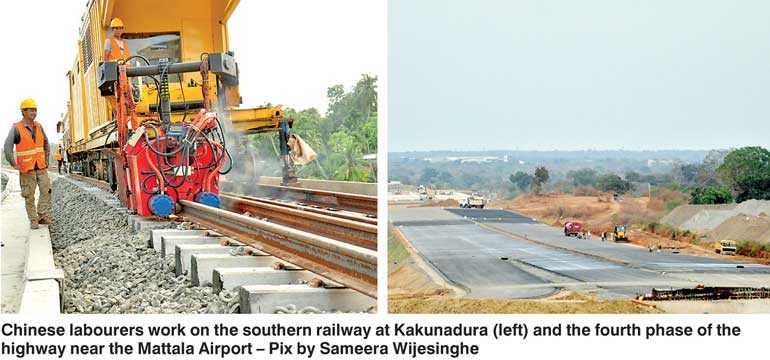Saturday Dec 14, 2024
Saturday Dec 14, 2024
Monday, 20 August 2018 00:00 - - {{hitsCtrl.values.hits}}

By Maleesha Sulthanagoda
China is confident of completing their multiple investments in southern Sri Lanka with the fourth phase of the highway from Mattala Airport to the Hambantota Port and the Matara-Beliatta railway extension likely to be completed by January 2019, top officials said.
The railway project, funded by a $ 278 million loan from China EXIM Bank, is being built by the China National Machinery Import and Export Corporation (CMC). CMC Senior Consultant Engineer Pathmasiri Hallowita told reporters engaged in an observation visit organised by the Chinese embassy last week that they had completed 90% of the work on the 26.75 km long extension from Matara to Beliatta.
“This is one of the most technologically advanced railway lines in Sri Lanka. The construction work on the Kekunadura Railway station is near completion. It is a dual-floored station building that contains quarters for the staff. This is also connected to a supermarket for the convenience of the travellers. This is the most modern railway line in Sri Lanka where a train can operate at a speed limit of 120 kmph, and operations are slated to commence in four to five months,” he said.
About 1,500 local workers and about 300 Chinese workers engaged in the construction of the railway extension project. He also added that the final stage of the first phase will include main railway stations in Kekunadura, Bambarenda, Wewrukannala and Beliatta. It was also said that there will also be two substations along the new railway extension.
Officials from the construction company also mentioned that the longest railway bridge in Sri Lanka was being constructed at Wattegama, which is 1.5 km in length, and the longest railway was also built at Nakutiya at 616 m in length as a result of this project.
The fourth phase of the Southern Highway, which is a stretch of 23 km, connects Mattala Airport with the Hambantota Port. Built at a cost of $ 6.23 million, the section is also expected to be completed by 19 January 2019. The rest of the phases, which is Matara to Beliatta at 30 km, Beliatta to Wetiya at 26 km and the third section from Wetiya to Andarawewa at 15 km, are also targeted to be completed after September 2019. Officials noted that delays in the construction were largely due to complications linked to land acquisition with as many as 50 families needing to be relocated.
“The length of the fourth section is 23 km. In the original plan it was 25 km, but later we reduced it to 23 km as the road to the airport was in good condition. We have completed more than 75% of the work. About 80% of the material used in the construction is from Sri Lankan suppliers,” Southern Highway extension Section Four Project Director A.P.K. Abeydeera.
When the full $ 1.9 billion project is completed, people will be able to travel from Kottawa to Kataragama in three and a half hours, officials said. The fourth phase is being constructed by China Communication Constructions, with consultation from the China Harbour Engineering Company and funding from China Exim Bank.
The Hambantota Port was also seeing progress with increases in its operations. The Hambantota International Port (HIP) handled 106,135 vehicles and 153 ships in the first half of 2018, when compared with the 109,716 vehicles handled in 2017, a top official of the Hambantota International Ports Group said on Friday.
HIPG Chief Operating Officer Tissa Wickramasinghe said that the Roll-on Roll-off (RORO) volumes handed by the HIP had increased during the past two years.
“Operations at HIP commenced with RORO and will continue to develop in a phased format. RORO volumes have increased over the years. In the first half of 2018, HIP handled 106,135 vehicles and 153 ships, while in 2017 we only handled 109,716 vehicles. We project a year-on-year growth of 85%,” he said.
He went on to reveal the projected growth of the port for the future and their future plans for the port.
“HIP was developed as a multi-purpose port. It was designed to handle Roll-on Roll-off (RORO), passengers, oil, bulk cargo, gas, project cargo and for container handling. The HIP was built to handle a gamut of services in the maritime and logistics area. The feasibility studies done before the construction of the port also showed that bulk cargo would constitute the main traffic to the port until 2030, and it also highlights that the port would be able to handle 20 million TEUs by 2040,” he added.